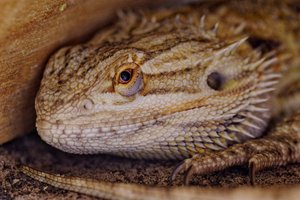
The reptile liver comprises approximately 3-4% of its total body mass, however, this can fluctuate with season, nutrition, or reproductive status. Embryonically the liver actually develops from tissue of the endodermal gut. Most reptiles’ livers consist of 2 lobes and vary from dark brown to black in color. Typically a gallbladder is present in most reptiles as well.
Liver function in reptiles is similar to mammals and birds which includes fat, protein, and glycogen metabolism along with uric acid production and creation of blood clotting factors. However, the metabolism of the reptile liver varies greatly with maturation, reproductive status, brumation, and seasonality.
Unlike birds and mammals, reptiles store very little of their body fat subcutaneously. Instead, excess fat is often stored in the liver. Fat reserves in reptiles still serve the same function as we see in mammals or birds – a source of energy during fasting, hibernation, and development of eggs or babies (live-bearing reptiles).
Hepatic lipidosis is a chronic condition where the liver contains excessive amounts of fat, leading to issues with liver function. Reptiles with excessive fat in the liver are also more prone to complications any time they go off of food.
Lizards fed a high-fat diet (insect larvae, pinky mice) or high carbohydrate (fruits) diets are very prone to obesity and development of hepatic lipidosis. Savannah monitors and tegus commonly present to the veterinarian with this condition, especially when fed an inappropriate, rodent-only diet. Tortoises may also develop this condition when fed a diet with excessive carbohydrates and sugars such as a diet of mostly store-bought vegetables and fruits with little hay.
Not eating following hibernation can increase the risk of hepatic lipidosis. Female reptiles often develop a healthy increase of fat in the liver right before producing eggs. If no eggs are produced this excessive fat may remain year after year, resulting in obesity and hepatic lipidosis.
Owners often report a gradual decrease in activity, loss of appetite, vomiting or regurgitation, diarrhea, green urates, or change in stool color or consistency. Reptiles with hepatic lipidosis are almost always either obese or recently lost weight and were obese before becoming ill. Your veterinarian may also find your pet is dehydrated and weak. Fluid may be present either under the skin or within the body cavity. In severe cases, toxins may build up in the bloodstream as the liver stops functioning properly resulting in neurological symptoms such as incoordination, change in mentation, tremors, or seizures.
Because hepatic lipidosis is a chronic condition, often early on reptiles have no outward symptoms. Symptoms often set in once the patient is no longer able to compensate for the decreased liver function.
Conditions with similar symptoms include bacteria or viral hepatitis, liver toxins, and conditions involving the gall bladder and bile ducts within the liver including cholangitis, cholecystitis, and cholecystolithiasis. Liver tumors may also appear similar to hepatic lipidosis as well.
Your veterinarian will start by recommending a complete blood count and serum biochemistry panel to evaluate your pet’s overall condition and liver involvement. Radiographs may be recommended and reveal an enlarged liver. Ultrasound is very useful in diagnosing hepatic lipidosis, where the liver will appear brighter than normal. Surgical biopsy gives a definitive diagnosis for this condition.
Patients who are still doing well and eating on their own should be switched to a more appropriate, healthy diet. Those who are sick and not eating, need long-term nutritional support and recovery may take weeks to months until they start eating on their own again. A feeding tube may be useful, especially in difficult to assist feed patients such as tortoises or more difficult-to-handle lizards. Fluid support may also be recommended. Your veterinarian may also prescribe supplements to help with liver function such as milk thistle, SAMe, and/or carnitine. If any other underlying illnesses are present, treatment should also address those as well.
Regurgitation is a poor prognostic indicator. Those who are still eating have a guarded prognosis until the condition has resolved. Those patients not eating have a guarded to poor prognosis.
Copyright © All Rights Reserved
